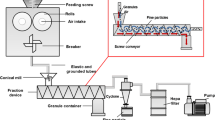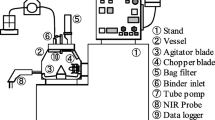Abstract
This work is an extension of the earlier work from this laboratory aimed at identifying raw material properties critical to the modeling of granule and ribbon properties as part of the optimization of roller (RC) compaction processes. The utility of roll gap (RG) and near-infrared (NIR) signal, specifically, the spectral slope, as process critical control parameters (PCCPs) was also evaluated. Raw material tabletability, particle size, size distribution span, and tapped density were found to be most important factors for building robust predictive models. RG and NIR spectral slope in combination with RC operating parameters yielded models with good predictability for RC responses. Our results support the suitability of RG and NIR spectral slope as PCCPs in roller compaction, specifically, through ribbon density monitoring.









Similar content being viewed by others
Abbreviations
- 1/b :
-
Kawakita constant
- a :
-
Kawakita constant
- Bulk:
-
bulk density
- C :
-
fractional powder volume reduction upon tapping
- DoE:
-
design of experiment
- Fall:
-
angle of fall
- G/RM_PS:
-
ratio of granule to raw material particle size
- G/RM_TTS:
-
ratio of granule to raw material tablet tensile strength
- GMPS:
-
granule mean particle size
- GTTS:
-
tensile strength of tablets made from granules
- HFS:
-
horizontal feed screw speed
- ICH:
-
International Conference on Harmonization
- MCC:
-
microcrystalline cellulose
- MCC Frac:
-
weight fraction of MCC in formulation
- MgSt:
-
magnesium stearate
- NIR:
-
near infrared
- PAT:
-
process analytical technology
- PC:
-
principal component
- PCCP:
-
process critical control parameter
- PLS:
-
partial least squares
- PS:
-
particle size
- QbD:
-
quality by design
- RC:
-
roller compaction
- RG:
-
roll gap
- RMTTS:
-
raw material tablet tensile strength
- RP:
-
roll pressure
- RS:
-
roll speed
- SF:
-
solid fraction
- Span:
-
span in particle size distribution, \({\rm{Span = }}\frac{{X_{90} {\rm{ }} - {\rm{ }}X_{10} }}{{X_{50} }}\)
- Tap:
-
tap density
- VFS:
-
vertical feed screw speed
- VIP:
-
variable importance on projection
- V N :
-
powder volume after N taps
- V o :
-
powder initial volume
- ρ b :
-
powder bulk density
- ρ t :
-
powder tap density
- N :
-
number of taps
- ε :
-
porosity
- ρapp :
-
ribbon apparent density
- σ t :
-
tensile strength
- ρ T :
-
true density
References
Soh JLP, Wang F, Boersen N, Pinal R, Peck GE, Cheney J, Valthorsson H, Pazdan J, Carvajal MT. Modeling the effects of raw material properties and operating parameters on ribbon and granule properties prepared in roller compaction using multivariate data analysis. Drug Dev Ind Pharm 2007 (in press).
Hariharan M, Wowchuk C, Nkansah P, Gupta VK. Effect of formulation composition on the properties of controlled release tablets prepared by roller compaction. Drug Dev Ind Pharm 2004;30 (6):565–72.
Inghelbrecht S, Remon JP. Roller compaction and tableting of microcrystalline cellulose drug mixtures. Int J Pharm 1998a;161 (2):215–24.
Cohn R, Heilig H, Delorimier A. Critical evaluation of the compactor. J Pharm Sci 1966;55 (3):328–31.
Inghelbrecht S, Remon JP. Reducing dust and improving granule and tablet quality in the roller compaction process. Int J Pharm 1998;171 (2):195–206.
Johanson JR. A rolling theory for granular solids. J Applied Mech 1965;32:842–8.
Simon O, Guigon P. Correlation between powder-packing properties and roll press compact heterogeneity. Powder Tech 2003;130:257–64.
Turkoglu M, Aydin I, Murray M, Sakr A. Modeling of a roller-compaction process using neural networks and genetic algorithms. Eur J Pharm Biopharm 1999;48 (3):239–45.
Dec RT, Zavaliangos A, Cunningham JC. Comparison of various modeling methods for analysis of powder compaction in roller press. Powder Tech 2003;130 (1–3):265–71.
Gupta APG, Miller RW, Morris KR. Real-time near-infrared monitoring of content uniformity, moisture content, compact density, tensile strength, and young’s modulus of roller compacted powder blends. J Pharm Sci 2005;94 (7):1589–97.
Gupta APG, Miller RW, Morris KR. Nondestructive measurements of the compact strength and the particle-size distribution after milling of roller compacted powders by near-infrared spectroscopy. J Pharm Sci 2004;93 (4):1047–53.
Gupta APG, Miller RW, Morris KR. Influence of ambient moisture on the compaction behavior of microcrystalline cellulose powder undergoing uni-axial compression and roller-compaction: a comparative study using near-infrared spectroscopy. J Pharm Sci 2005;94 (10):2301–13.
Gupta APG, Miller RW, Morris KR. Effect of the variation in the ambient moisture on the compaction behavior of powder undergoing roller-compaction and on the characteristics of tablets produced from the post-milled granules. J Pharm Sci 2005;94 (10):2314–26.
Carr RL. Evaluating flow properties of solids. Chem Eng 1965;72:163–8.
Hausner HH. Friction conditions in a mass of metal powder. Int J Powder Metall 1967;3:7–13.
Ludde KH, Kawakita K. Die pulverkompression. Pharmazie 1967;21:93–403.
Beebe KR, Pell RJ, Seasholtz MB. Chemometrics—a practical guide. New York: Wiley; 1998. p. 280.
Acknowledgment
The authors thank the Consortium for the Advancement of Manufacturing of Pharmaceuticals (CAMP) for the funding of this work and especially Novartis Pharmaceuticals Corporation for providing the facilities where the roller compaction work was performed. Students from the Massachusetts Institute of Technology (MIT) Practice School are acknowledged for the help in the roller compaction. The assistance of Victor Hildebrand in the characterization work is also appreciated. A special gratitude is extended to Professor Rodolfo Romañach, University of Puerto Rico at Mayagüez, for stimulating discussions on this research.
Author information
Authors and Affiliations
Corresponding author
Rights and permissions
About this article
Cite this article
Soh, J.L.P., Boersen, N., Carvajal, M.T. et al. Importance of Raw Material Attributes for Modeling Ribbon and Granule Properties in Roller Compaction: Multivariate Analysis on Roll Gap and NIR Spectral Slope as Process Critical Control Parameters. J Pharm Innov 2, 106–124 (2007). https://doi.org/10.1007/s12247-007-9013-z
Received:
Accepted:
Published:
Issue Date:
DOI: https://doi.org/10.1007/s12247-007-9013-z




